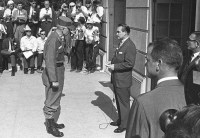The Case For Women
I’ve just finished what I think is an important book for our time: Lean In: Women, Work, and The Will to Lead. The author is Sheryl Sandberg, the COO of Facebook. She makes a compelling case for the greater involvement of women in every facet of leadership in today’s society.
Sandberg is a staunch believer in the right and obligation of every woman to choose the life that fulfills her, whether it’s in the home, or in the world at large, or some combination of the two. She says it is all honorable and valued work. But the crux of her message is for women who choose careers in the public arena – especially, business and government. Her fervent advice for those women: welcome challenges, take risks, boldly seek opportunities to lead. Sandberg lives her advice. She leads one of the world’s most successful, most vibrant businesses. She has found balance in life, dedicating herself equally to her family – husband, children, home.
While reading her book, I thought about the raising of our own two daughters. My wife and I encouraged them to think boldly about their futures, to choose the paths that suited them. “You can be whatever you want to be,” we told them, “and we will help you prepare yourselves and overcome obstacles.” They’ve chosen different paths, but the important thing is, we made sure they felt free to choose.
I also thought that Sheryl Sandberg was talking about the central character of my new novel, The Governor’s Lady. Cooper Lanier, after spending much of her life in the shadow of politics and politicians, chooses to leap headlong into that world. She is elected governor of her southern state, and makes the choice to fight for her place in the often-treacherous world of male-dominated politics. She welcomes challenge. She seeks leadership. She goes boldly. I love her for it. I think Sheryl Sandberg would be proud of Cooper Lanier.
As Cooper and her story unfolded in my imagination, I came firmly to the notion that we need more women in government at every level – local, state, federal, elected and appointed. We have a gracious plenty of testosterone in public life – men whose primary purpose often seems to be simply winning a point, skewering an opponent, advancing an ideology at all costs. (See Congress, United States). I think women often come at the business of governing from a different angle: What works? How can we get things done? How can we work together? We could use a great deal more of that.
Women are making strides, gaining ground, breaking glass ceilings. But not enough. We need to let them know that what they’re doing is important, valuable, enriching to all of us. We need to keep encouraging them to lean in.




